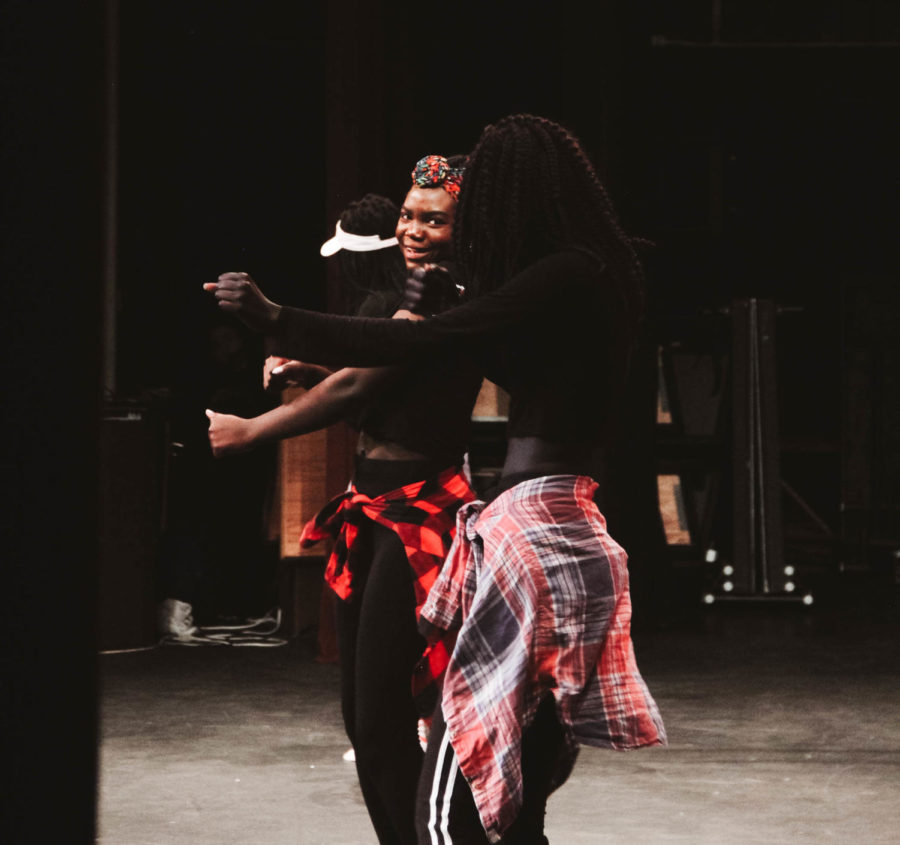Process To Become A Refugee Is Grueling
Tumaini Chikobe (center) performs with Adut Makuie and Benedith Naskin during the Talents & Traditions assembly.
February 19, 2019
Nearly 65 million people around the globe, approximately 24 men, women or children per minute, are displaced by conflict and persecution.
Millions of these people come into the United States every year. Some are escaping war, some are coming to make money, and some are trying to raise their families in a safe place. Although the misconception exists to the contrary, refugees aren’t people living in the country illegally and they aren’t here to commit any type of crime. In fact, the steps they have to take in order to find success is more than most could ever imagine.
The U.S. law defines refugees as “migrants who are able to demonstrate that they have been persecuted, or have reason to fear persecution, on the basis of one of five ‘protected grounds.’” These include race, religion, nationality, political opinion, and membership in a particular social group.
These people are invited into the country and they are welcome when they arrive. They’re given protection at an international level and are in the U.S. legally. They are not illegal immigrants, even though most are not citizens. The much-debated border wall is not to keep refugees out. In fact, all refugees are invited in.
Refugees are people who leave their hometowns in order to be safe, while many others choose to travel somewhere new because of many issues including financial struggles and environmental concerns.
“It wasn’t safe and there’s no freedom,” Highland student, Paw Si, said. “Even though there is education [in Thailand], a lot of people can’t get it.”
Teenagers, along with people of all ages, are forced from their homes all over the world in hopes of finding a better life.
Si came to Utah from Thailand with her family in the winter of 2009.
“It was a long, long, long process,” Si said. “You have to do interviews, your parents have to do interviews, there’s paperwork, and they train you for how things work when you get to America.”
From the very moment a refugee gathers their belongings and heads for the U.S, the fight begins.
The UN Refugee Agency “works to assist and protect refugees everywhere,” and find people and families in need. Resettlement Support Centers then help to put together case files that include photos and information about the situation to present to Homeland Security.
This period of time can take days, months, or years.
After approval of the family’s application, all refugees traveling to the United States must undergo required medical examinations. After a U.S. refugee agency finds a sponsor for the family, their trip is scheduled.
Sponsors of refugees, whether through small or large organizations, must live in certain states with certain benefits for refugees, go through a series of trainings, and provide proof of sufficient financial resources.
Housing, food, clothing, and other necessities are available when they arrive in their new home, and access to social, medical, and employment services are provided within the first three months.
Although they have things that everyone would hope to have, the struggle doesn’t end here.
Trying to learn the English language, raising kids, finding work, and many other day-to-day things can become a complication.
“I didn’t know any [English],” Si said. “I was so scared of where the bathrooms were, how to use the stove when cooking at home; it was really hard.”
Along with learning a new language, cultural barriers overshadow life for refugees. Misconceptions and misunderstandings are a common issue that makes almost everything these people go through much harder.
High school culture is possibly even more frustrating for people new to an area. Dances, sporting events, clubs, and other similar ideas seem completely normal to most students, but may seem completely “out of the norm” to others.
Victoria Saley, ELL student and family advocate, works with refugee students at Highland that are experiencing high school for the very first time in a brand new environment. She witnesses them facing these problems on a day-to-day basis.
“We want to give [the refugee students] more opportunities,” Saley said. “I’m always trying to include them and help them know what things are out there.”
She wants to encourage others to reach out, communicate with students from different backgrounds, and include them in all things “high school.”
The more people that approach these students both at school and in the community, the more and more welcome they will feel.
“It really is just reaching out to students from different countries and including them in activities, sports, and other programs,” Saley said. “Because a lot of times they just don’t know where to start.”
Although the start of every refugee’s process is the moment tragedy strikes, “beginning again” in a new country, with a new language, in a culture that is completely different, is one crazy ride.




























